Know More about Miyagase Dam
-
Construction of the Dam
History behind Construction of Miyagase Dam
Work on construction of Miyagase Dam was completed in December 2000 thanks to the cooperation of persons who moved away from the land they had lived on for many years, landowners who had inherited land from their ancestors, the relevant public agencies, and work-related parties. Here, we introduce the history behind construction of Miyagase Dam as recorded through photographs showing each stage from building of the dam works road to filling of the dam reservoir with water.
Record of Miyagase Dam in Photographs
-
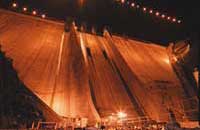 Night view from beneath the dam (1994)
Night view from beneath the dam (1994)
-
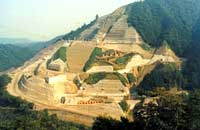 Foundation excavation works on the right bank top part (1990)
Foundation excavation works on the right bank top part (1990)
-
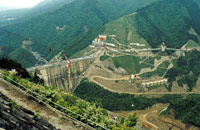 Dam body viewed from the quarry (1994)
Dam body viewed from the quarry (1994)
-
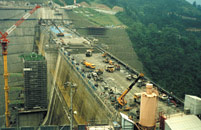 RCD concrete construction (1993)
RCD concrete construction (1993)
-
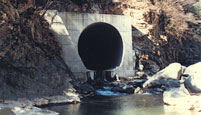 Dam downstream diversion works (1988)
Dam downstream diversion works (1988)
-
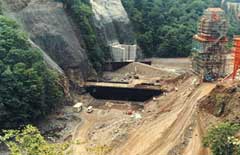 Dam upstream secondary coffering works (1988)
Dam upstream secondary coffering works (1988)
-
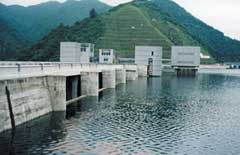 Dam when full (1998)
Dam when full (1998)
-
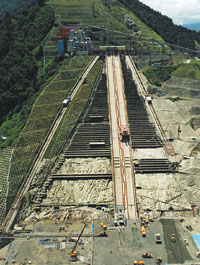 RCD concrete construction utilizing incline (1992)
RCD concrete construction utilizing incline (1992)
-
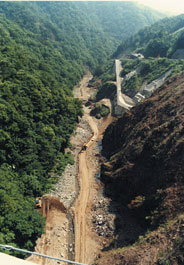 Construction of works road (1988)
Construction of works road (1988)
History of the Construction of Miyagase Dam
Various technologies and measures were adopted in the construction of Miyagase Dam. Planned environmental measures minimized the impact of construction work and other development on the surrounding natural environment, while efforts were also made to restore nature that was lost in the construction so as to preserve the rich natural environment and character of the area.
In addition, to conduct this large-scale construction works in an efficient way, the Roller Compacted Dam-Concrete (RCD) Method was adopted in the design and construction, while an inclined railway to carry the dump trucks and other new technologies were utilized to minimize construction costs as well as the construction time.About the RCD Method
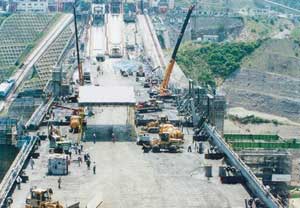 Implementation of RCD Concrete Method (1993)
Implementation of RCD Concrete Method (1993)
The Roller Compacted Dam-Concrete (RCD) Method was chosen for the construction of Miyagase Dam to ensure the effective and economic placement of about 2 million m³ of concrete. This method was developed by the then Ministry of Construction (current Ministry of Land, Infrastructure and Transport) to level and compact thick concrete containing a small proportion of cement. Compared to traditional methods, the RCD Method is not only safer, but results in shorter construction times and lower costs.
 Flow of RCD Method
Flow of RCD Method
History of Miyagase Dam
April 1969 Sagamigawa River was designated as Class A river (public notice) September Construction plan was announced by the former Ministry of Construction April 1971 Miyagase Dam Research Office established April 1974 Name changed to Miyagase Dam Work Office August 1976 Land ownership survey initiated (Kiyokawa-mura, Tsukui-machi) March 1977 Designated as a dam in Special Measures for Water Source Area Law (public notice) June Alternate site for Miyanosato area approved May 1978 Ishigoya chosen as dam site October Relocation framework for lake area announced (currently Miyanohira, and Mizunogo) December Basic Plan of Miyagase Dam decided (public notice) May 1979 Planned site of rivers designated (public notice) December General indemnity standard presented (Kiyokawa-mura, Tsukui-machi) March 1980 Water source area designated based on Special Measures for Water Source Area Law (public notice)
Improvement plan of water source area completed (implemented as a promotion plan)July Land ownership survey started in Ishigoya area, Aikawa-machi August 1981 General indemnity standard agreed for areas to be submerged (Kiyokawa-mura, Tsukui-machi) April 1982 General completion of alternate site for Miyanosato area (relocation started in August) September General completion of alternate site A (Miyanohira) December Indemnity standard agreed for Toriibara area (Tsukui-machi) January 1983 Indemnity standard agreed for Nirone area (Tsukui-machi) February Indemnity standard agreed for the construction road Hibirano Mukaihara Line (Aikawa-machi) March Full-scale start of construction of accessory roads
General completion of alternate grave siteNovember Relocation of tourist agent in Ishigoya area started March 1984 Work for provisional drain tunnel started June General indemnity standard agreed for dam site (Aikawa-machi) March 1985 General completion of alternate site B (Mizunogo) March 1986 Conclusion of agreement on research in relation to plans for the Doshi and Tsukui Channels November Alteration of Basic Plan of Miyagase Dam decided (public notice) March 1987 Agreement on indemnity for fisheries in relation to the construction of Miyagase Dam (Sagamigawa River Fisheries Cooperative) November Construction of dam body started February 1988 Transfer to provisional drain tunnel started October 1989 Excavation works of dam body started March 1990 Conclusion of agreement in relation to works to build the Doshi and Tsukui Channels (Toriya and Kushikawa areas) February 1991 Opening of prefectural road Hadano-Kiyokawa Line March Conclusion of agreement in relation to works to build Doshi Channel (Aone area) October Pouring of concrete for dam body started (foundation ceremony held in November) February 1993 Construction of Tsukui Channel started March Construction of Ishigoya Dam and Doshi Channel started July 1994 Transfer to provisional drain tunnel started at Ishigoya Dam November Opening of prefectural road Isehara-Tsukui Line
Placement of concrete for dam body completedJanuary 1995 Pouring of concrete in Ishigoya Dam started (foundation ceremony was held in March) October Filling test started March 1996 Opening of prefectural road Miyagase-Aikawa Line April Placement of concrete in Ishigoya Dam completed November Opening of Hayatogawa Forest Road April 1997 Operation of Aikawa Power Station No.1 and No.2 started October Tsukui Channel completed June 1998 Lake Miyagase reached full capacity (birth of Miyagase Dam) September Canoe competition in the 53rd National Athletic Meet held October Filling test completed December Restart of Doshi Channel construction was approved by local residents April 1999 Operation of dam body and Tsukui Channel partially started November 2000 Doshi Channel completed April 2001 Full-scale operation of Miyagase Dam started" -
